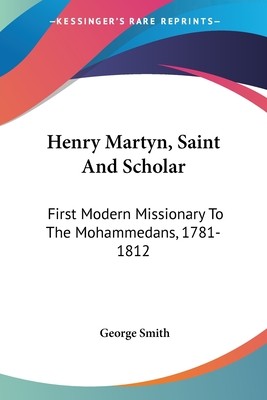
- We will send in 10–14 business days.
- Author: George Smith
- Publisher: Kessinger Publishing
- ISBN-10: 1432645420
- ISBN-13: 9781432645427
- Format: 15.2 x 22.9 x 3.4 cm, minkšti viršeliai
- Language: English
- SAVE -10% with code: EXTRA
Reviews
Description
Henry Martyn (1781 –1812) was the first modern missionary to Moslems in India, Persia, and Turkey; his self-sacrificing career of missionary service in India and Persia made him a hero of the Anglican Church."The story of his attempts to convert the Mohammedans has a quaint interest of its own." - Westminster Review
Five centuries of inactivity on the mission field faced Henry Martyn when he became the first modern missionary to Moslems. In his 1892 book "Henry Martyn: Saint and Scholar," George Smith (1833-1919) relates the record of a life great in its experience and greater in its influence, one that is of standard rank in missionary history.
Henry Martyn was an Anglican priest and missionary to the peoples of India and Persia. A chance encounter with Charles Simeon led him to become a missionary. He was ordained a priest in the Church of England and became a chaplain for the British East India Company. Before his arrival he had already studied Sanscrit, Persian and Arabic, and afterwards he labored unceasingly by tongue and pen, by preaching and by prayer.
Martyn arrived in India in April 1806, where he preached and occupied himself in the study of linguistics. He translated the whole of the New Testament into Urdu, Persian and Judaeo-Persic. He also translated the Psalms into Persian and the Book of Common Prayer into Urdu. From India, he set out for Bushire, Shiraz, Isfahan, and Tabriz.
In 1811 Martyn set foot on Persian soil. He had not been two months in Shiraz before he became “the town talk.” The people thought he had come to declare himself a Mussulman, and would then bring a force of five thousand men to take possession of the city. Many Mohammedans, who were dissatisfied with their own government, longed for that English rule which was making India peaceful and prosperous. Visitors from all parts crowded round the saintly missionary, who lost no opportunity of proclaiming Christ. His words were producing such an effect that the highest Mohammedan priest found it necessary to interfere. But the intervention of the Moojtahid only added to the sensation which Martyn had excited among all classes. This part of the biography is profoundly interesting.
Martyn was seized with fever, and, though the plague was raging at Tokat, he was forced to stop there, unable to continue. On 16 October 1812 he died. He was remembered for his courage, selflessness and his religious devotion. In parts of the Anglican Communion he is celebrated with a Lesser Festival on 19 October.
EXTRA 10 % discount with code: EXTRA
The promotion ends in 22d.19:23:30
The discount code is valid when purchasing from 10 €. Discounts do not stack.
- Author: George Smith
- Publisher: Kessinger Publishing
- ISBN-10: 1432645420
- ISBN-13: 9781432645427
- Format: 15.2 x 22.9 x 3.4 cm, minkšti viršeliai
- Language: English English
"The story of his attempts to convert the Mohammedans has a quaint interest of its own." - Westminster Review
Five centuries of inactivity on the mission field faced Henry Martyn when he became the first modern missionary to Moslems. In his 1892 book "Henry Martyn: Saint and Scholar," George Smith (1833-1919) relates the record of a life great in its experience and greater in its influence, one that is of standard rank in missionary history.
Henry Martyn was an Anglican priest and missionary to the peoples of India and Persia. A chance encounter with Charles Simeon led him to become a missionary. He was ordained a priest in the Church of England and became a chaplain for the British East India Company. Before his arrival he had already studied Sanscrit, Persian and Arabic, and afterwards he labored unceasingly by tongue and pen, by preaching and by prayer.
Martyn arrived in India in April 1806, where he preached and occupied himself in the study of linguistics. He translated the whole of the New Testament into Urdu, Persian and Judaeo-Persic. He also translated the Psalms into Persian and the Book of Common Prayer into Urdu. From India, he set out for Bushire, Shiraz, Isfahan, and Tabriz.
In 1811 Martyn set foot on Persian soil. He had not been two months in Shiraz before he became “the town talk.” The people thought he had come to declare himself a Mussulman, and would then bring a force of five thousand men to take possession of the city. Many Mohammedans, who were dissatisfied with their own government, longed for that English rule which was making India peaceful and prosperous. Visitors from all parts crowded round the saintly missionary, who lost no opportunity of proclaiming Christ. His words were producing such an effect that the highest Mohammedan priest found it necessary to interfere. But the intervention of the Moojtahid only added to the sensation which Martyn had excited among all classes. This part of the biography is profoundly interesting.
Martyn was seized with fever, and, though the plague was raging at Tokat, he was forced to stop there, unable to continue. On 16 October 1812 he died. He was remembered for his courage, selflessness and his religious devotion. In parts of the Anglican Communion he is celebrated with a Lesser Festival on 19 October.


Reviews